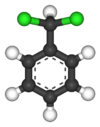Benzal chloride
|
|
|||
| Names | |||
|---|---|---|---|
|
Preferred IUPAC name
(Dichloromethyl)benzene
|
|||
Other names
|
|||
| Identifiers | |||
|
3D model (Jmol)
|
|||
| 1099407 | |||
| ChemSpider | |||
| ECHA InfoCard | 100.002.463 | ||
| EC Number | 249-854-8 | ||
| KEGG | |||
| MeSH | Compounds Benzylidene Compounds | ||
|
PubChem CID
|
|||
| RTECS number | CZ5075000 | ||
| UNII | |||
| UN number | 1886 | ||
|
|||
|
|||
| Properties | |||
| C7H6Cl2 | |||
| Molar mass | 161.03 g/mol | ||
| Appearance | Colorless liquid | ||
| Density | 1.254 g/cm3, liquid | ||
| Melting point | −17 to −15 °C (1 to 5 °F; 256 to 258 K) | ||
| Boiling point | 205 °C (401 °F; 478 K) (82 °C @10 mm Hg) | ||
| 0.25 g/L at 39 °C | |||
| Vapor pressure | 0.6 kPa (45 °C) | ||
| Hazards | |||
|
EU classification (DSD)
|
Toxic (T), Carc. Cat. 2B, Dangerous for the environment (N) | ||
| R-phrases | 22-23-37/38-40-41 | ||
| S-phrases | 36/37-38-45 | ||
| Flash point | 93 °C (199 °F; 366 K) | ||
|
Except where otherwise noted, data are given for materials in their standard state (at 25 °C [77 °F], 100 kPa).
|
|||
|
|
|||
| Infobox references | |||
Benzal chloride is an organic compound with the formula C6H5CHCl2. This colourless liquid is a lachrymator and is used as a building block in organic synthesis.
Benzal chloride is produced by the free radical chlorination of toluene, being preceded in the process by benzyl chloride (C6H5CH2Cl) and followed by benzotrichloride (C6H5CCl3):
Benzylic halides are typically strong alkylating agents, and for this reason benzal chloride is treated as a hazardous compound.
Treatment of benzal chloride with sodium gives stilbene.
Most benzal chloride main industrial use is as a precursor to benzaldehyde. This conversion involves hydrolysis in the presence of base:
...
Wikipedia


